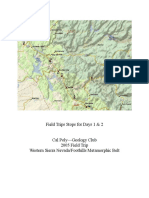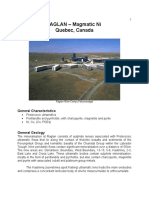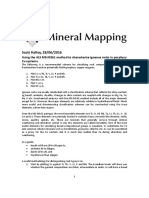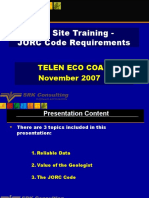0 ratings0% found this document useful (0 votes)
Paragenesis and Zoning
Paragenesis and Zoning
Uploaded by
Irwan EPThe document discusses paragenesis and zoning in ore deposits. Paragenesis refers to the sequence in which ore and gangue minerals are deposited, while zoning looks at the distribution of ore minerals both laterally and vertically. In general, ore deposits show a similar pattern of paragenesis, with magnetite, silicates, and cassiterite deposited early followed later by pyrrhotite, chalcopyrite, and galena. Zoning can be defined by changes in minerals, metal concentrations or ratios, and is seen on regional, district, ore body, and syngenetic hydrothermal scales following sequences from Fe to Pb.
Copyright:
© All Rights Reserved
Available Formats
Download as DOC, PDF, TXT or read online from Scribd
Download as doc, pdf, or txt
Paragenesis and Zoning
Paragenesis and Zoning
Uploaded by
Irwan EP0 ratings0% found this document useful (0 votes)
The document discusses paragenesis and zoning in ore deposits. Paragenesis refers to the sequence in which ore and gangue minerals are deposited, while zoning looks at the distribution of ore minerals both laterally and vertically. In general, ore deposits show a similar pattern of paragenesis, with magnetite, silicates, and cassiterite deposited early followed later by pyrrhotite, chalcopyrite, and galena. Zoning can be defined by changes in minerals, metal concentrations or ratios, and is seen on regional, district, ore body, and syngenetic hydrothermal scales following sequences from Fe to Pb.
Original Title
Paragenesis and Zoning.doc
Copyright
© © All Rights Reserved
Available Formats
DOC, PDF, TXT or read online from Scribd
Share this document
Did you find this document useful?
Is this content inappropriate?
The document discusses paragenesis and zoning in ore deposits. Paragenesis refers to the sequence in which ore and gangue minerals are deposited, while zoning looks at the distribution of ore minerals both laterally and vertically. In general, ore deposits show a similar pattern of paragenesis, with magnetite, silicates, and cassiterite deposited early followed later by pyrrhotite, chalcopyrite, and galena. Zoning can be defined by changes in minerals, metal concentrations or ratios, and is seen on regional, district, ore body, and syngenetic hydrothermal scales following sequences from Fe to Pb.
Copyright:
© All Rights Reserved
Available Formats
Download as DOC, PDF, TXT or read online from Scribd
Download as doc, pdf, or txt
0 ratings0% found this document useful (0 votes)
Paragenesis and Zoning
Paragenesis and Zoning
Uploaded by
Irwan EPThe document discusses paragenesis and zoning in ore deposits. Paragenesis refers to the sequence in which ore and gangue minerals are deposited, while zoning looks at the distribution of ore minerals both laterally and vertically. In general, ore deposits show a similar pattern of paragenesis, with magnetite, silicates, and cassiterite deposited early followed later by pyrrhotite, chalcopyrite, and galena. Zoning can be defined by changes in minerals, metal concentrations or ratios, and is seen on regional, district, ore body, and syngenetic hydrothermal scales following sequences from Fe to Pb.
Copyright:
© All Rights Reserved
Available Formats
Download as DOC, PDF, TXT or read online from Scribd
Download as doc, pdf, or txt
You are on page 1/ 3
Paragenesis and Zoning
Paragenesis - sequence of deposition of ore and gangue minerals. Determined from both
microscopic and megascopic studies.
Zoning - distribution of ore minerals in space laterally and vertically.
Paragenesis
In general, all deposits show a similar pattern, some anomalies are present, but these are
generally rare. General sequence as follows:
1. magnetite, ilmemite, hematite
2. silicates
3. cassiterite, wolframite, molybdenite
4. pyrrhotite, lollingite, arsenopyrite, pyrite, cobalt and nickel arsenides
5. chalcopyrite, bornite, sphalerite
6. galena, tetrahedrite, lead sulfosalts, tellurides, cinnabar
Of course, not all minerals are present in any one deposit and the above sequence is
highly simplified. See Figure for an example of a more detailed paragenetic sequence.
Zoning
Can be defined by changes in ore or gangue minerals or both, by changes in the
percentages of metals, or by changes in metal/metal ratios or even isotopic variation.
1. epigenetic hydrothermal zoning
o regional - large scale zoning which often shows a rough correspondence to
orogenic belts or plate boundaries.
o district - zoning on a district scale often related to intrusive centers of
facies changes in sedimentary rocks.
o ore body - changes within a single ore body.
2. syngenetic hydrothermal zoning - zoning relative to a central volcanic source.
Very similar between deposits and well documented. Sequence is Fe--> (Sn)-->
Cu--> Zn--> Pb-->Ag-->Ba. An overlap of zones is common.
3. sedimentary syngenetic zoning - found in sedimentary sulfide ore deposits.
Sequence is Cu+Ag--> Pb-->Zn.
You might also like
- Manual Epithermal & Porphyry - G.corbett 2018100% (3)Manual Epithermal & Porphyry - G.corbett 2018207 pages
- Application of Skarn Deposit Zonation Models To Mineral ExplorationNo ratings yetApplication of Skarn Deposit Zonation Models To Mineral Exploration24 pages
- 2021 Abs Extended Skarnzoning Proceeding-The13thMGEIAnnualConvention2021No ratings yet2021 Abs Extended Skarnzoning Proceeding-The13thMGEIAnnualConvention20217 pages
- A Mineral System Model For Intrusion-Related Gold DepositsNo ratings yetA Mineral System Model For Intrusion-Related Gold Deposits9 pages
- Epithermal Au-Ag Low-Sulfidation - PanteleyevNo ratings yetEpithermal Au-Ag Low-Sulfidation - Panteleyev4 pages
- BlenkinsopKadzviti2006 - Fluid Flow in Shear Zones Insights From The Geometry and Evolution of Ore Bodies at Renco Gold Mine, ZimbabweNo ratings yetBlenkinsopKadzviti2006 - Fluid Flow in Shear Zones Insights From The Geometry and Evolution of Ore Bodies at Renco Gold Mine, Zimbabwe13 pages
- The Source and Timing of Gold in Orogenic Gold Deposits - A Case Study From The Giant Bendigo Deposit. Implication For ExplorationNo ratings yetThe Source and Timing of Gold in Orogenic Gold Deposits - A Case Study From The Giant Bendigo Deposit. Implication For Exploration26 pages
- Role of Trace Elements in Petrogenesis: Presented by Guided by100% (1)Role of Trace Elements in Petrogenesis: Presented by Guided by22 pages
- Chemical Variations Tetrahedrite-TennantiteNo ratings yetChemical Variations Tetrahedrite-Tennantite6 pages
- Porphyry Copper Deposits - 2 - by W.J. Mcmillan For The B.C. & Yukon Chamber of MinesNo ratings yetPorphyry Copper Deposits - 2 - by W.J. Mcmillan For The B.C. & Yukon Chamber of Mines3 pages
- Atanas Hikov Атанас Хиков: Key words: paragonite, geochemistry, hydrothermal alteration, Asarel porphyry copper deposit,No ratings yetAtanas Hikov Атанас Хиков: Key words: paragonite, geochemistry, hydrothermal alteration, Asarel porphyry copper deposit,2 pages
- The Geological Characteristics Geochemical Signature and Geophysical Expression of Porphyry Copper Gold Deposits in The Circum Pacific RegionNo ratings yetThe Geological Characteristics Geochemical Signature and Geophysical Expression of Porphyry Copper Gold Deposits in The Circum Pacific Region5 pages
- Geochemical Classification of Lithology in PC DepositsNo ratings yetGeochemical Classification of Lithology in PC Deposits5 pages
- Magnetic Responses Associated With Mineral DepositsNo ratings yetMagnetic Responses Associated With Mineral Deposits14 pages
- 1982, Nesbitt, Metamorphic Sulfide-Silicate Equilibria in The Massive Sulfide Deposits at Ducktown, Tennessee, Economic GeologyNo ratings yet1982, Nesbitt, Metamorphic Sulfide-Silicate Equilibria in The Massive Sulfide Deposits at Ducktown, Tennessee, Economic Geology15 pages
- Zoning: Study of The Systematics of Spatial Variations:: Ore DepositsNo ratings yetZoning: Study of The Systematics of Spatial Variations:: Ore Deposits5 pages
- Sedimentary MN Deposits (MODEL 34b Cannon and Force, 1986)No ratings yetSedimentary MN Deposits (MODEL 34b Cannon and Force, 1986)4 pages
- Tugas G.4 Geokimia (Simson Paulus Taifa)No ratings yetTugas G.4 Geokimia (Simson Paulus Taifa)5 pages
- Introduction To Optical Mineralogy And Petrography - The Practical Methods Of Identifying Minerals In Thin Section With The Microscope And The Principles Involved In The Classification Of RocksFrom EverandIntroduction To Optical Mineralogy And Petrography - The Practical Methods Of Identifying Minerals In Thin Section With The Microscope And The Principles Involved In The Classification Of Rocks3.5/5 (2)
- Alpine Peridotite Podiform Chromite DepositsNo ratings yetAlpine Peridotite Podiform Chromite Deposits7 pages






































































